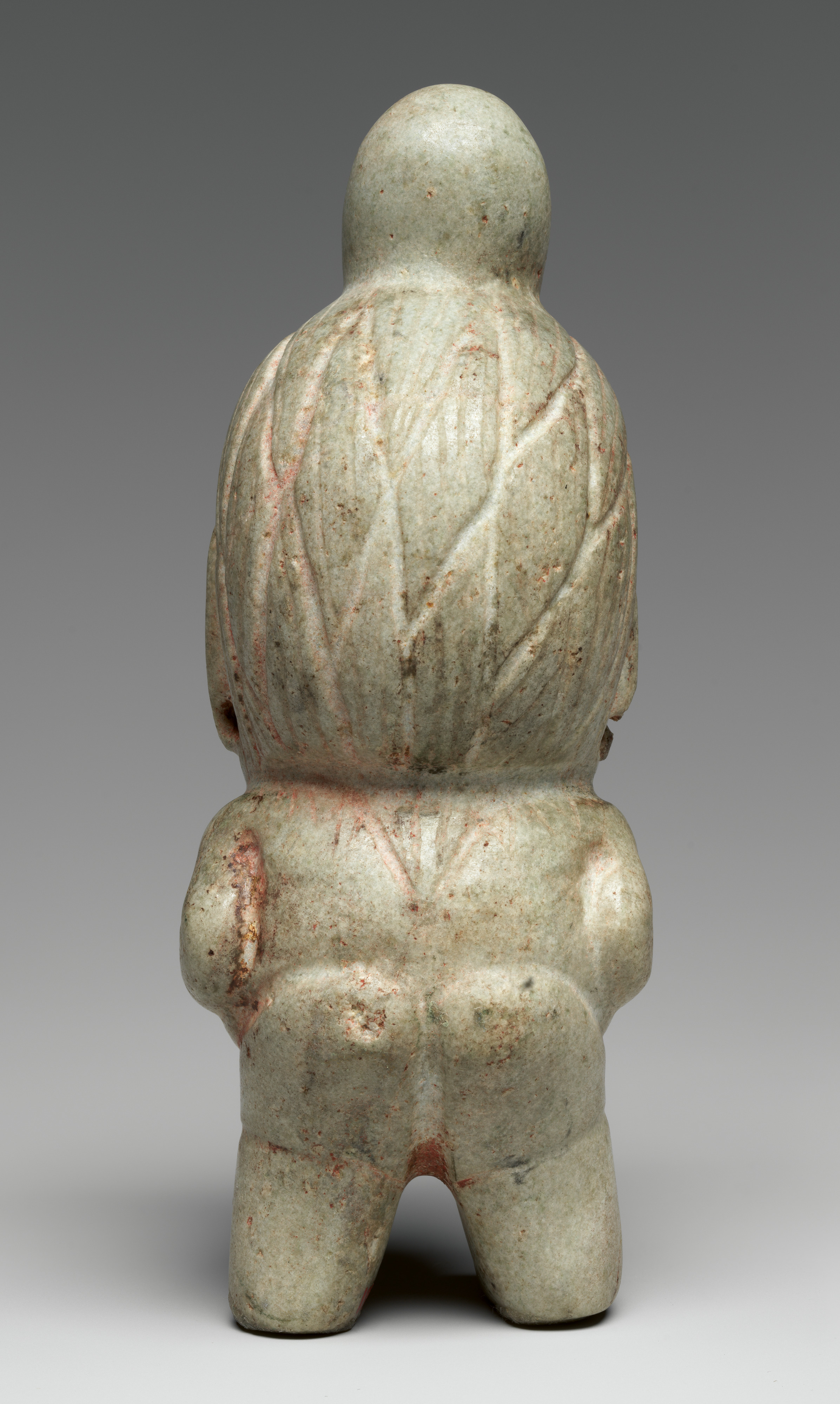Eagle Transformation Figure
Not on view
This small, carved sculpture in a whitish greenstone known as albite represents a standing figure bearing both human and avian attributes. The composition is dominated by the figure’s head which occupies the upper half, while the rotund torso with incised umbilicus and limbs are minimally indicated below. The large, spherical eyes are separated by a contoured crest that projects upward above a small nose. The figure’s mouth is an avian beak, partially open as if mid-vocalization. A small beard protrudes from the lower jaw, and similar hairlike incisions begin at the hairline and terminate in an overlapping pattern that might suggest a combination of hair and feathers. Humanlike ears contain tiny drilled holes which may have supported adornments. Such figures with protruding chests and arms bent at the elbow, drawn up close to the body, have been interpreted as human figures with non-standard bodies as a result of skeletal dysplasia.
The avian attributes on the head could be interpreted as a complex mask-and-headdress assemblage worn on a human performer, or as the fusion of a human and raptor as part of a spiritual narrative about transformation. Throughout the ancient Americas, leaders commissioned works to harness the predatory power of flying creatures. Avian figures feature prominently in Olmec art at small and large scale, such as the cave paintings found at Oxtotitlan, Guerrero, Mexico, that depict a ruler in full birdlike regalia. This figure may have been the personal deity of an Olmec ruler, perhaps later deposited in a funerary or dedicatory context, as indicated by traces of the pigment cinnabar.
Further reading
Benson, Elizabeth P., and Beatriz de la Fuente, eds. Olmec Art of Ancient Mexico. Washington, D.C.: National Gallery of Art, 1996.
Berrin, Kathleen, and Virginia M. Fields, eds. Olmec: Colossal Masterworks of Ancient Mexico. San Francisco: Fine Arts Museums of San Francisco, 2010.
Cheetham, David, and Jeffrey P. Blomster, eds. The Early Olmec and Mesoamerica: The Material Record. Cambridge: Cambridge University Press, 2017.
Clark, John E., and Michael Blake El origen de la civilización en Mesoamérica: Los Olmecas y Mokaya del Soconusco de Chiapas, Mexico. In El Preclásico o Formativo: Avances y perspectivas, Martha Carmona Macias, ed. Museo Nacional de Antropología, México City, 1989, pp. 385–403.
Clark, John E., and Michael Blake The Power of Prestige: Competitive Generosity and the Emergence of Rank Societies in Lowland Mesoamerica. In Factional Competition and Political Development in the New World, Elizabeth M. Brumfiel and John W. Fox, eds., Cambridge: Cambridge University Press, 1994, pp: 17– 30.
Clark, John E., and Mary Pye, eds. 2000 Olmec Art and Archaeology: Social Complexity in the Formative Period. Washington, D.C.: National Gallery of Art.
Coe, Michael D. The Jaguar’s Children: Pre-Classic Central Mexico. New York: Museum of Primitive Art, 1965.
Coe, Michael D. The Olmec Style and Its Distributions. In Handbook of Middle American Indians, vol. 3 (Robert Wauchope, gen. ed.). Austin: University of Texas Press, 1965, pp. 739–775
Coe, Michael D. (ed.) The Olmec World: Ritual and Rulership. Princeton: The Art Museum, Princeton University, 1996.
Coe, Michael D., and Richard A. Diehl 1980 In the Land of the Olmec: The Archaeology of San Lorenzo Tenochtitlán, 2 vols. Austin: University of Texas Press.
Covarrubias, Miguel Origen y desarrollo del estilo artístico “Olmeca.” In Mayas y Olmecas: Segunda reunión de Mesa Redonda sobre problemas antropológicos de México y Centro América. Mexico City: Talleres, 1942, pp. 46-49.
Cyphers Guillén, Ann From Stone to Symbols: Olmec Art in Social Context at San Lorenzo Tenochtitlán. In Social Patterns in Pre-Classic Mesoamerica (David C. Grove and Rosemary A. Joyce, eds.), Washington, D.C.: Dumbarton Oaks, 1999, pp. 155–181.
Drucker, Philip La Venta, Tabasco: A Study of Olmec Ceramics and Art. Smithsonian Institution, Bureau of American Ethnology, Bulletin 153. Washington, D.C.: Government Printing Office, 1952.
Drucker, Philip, Robert F. Heizer, And Robert J. Squier 1959 Excavations at La Venta, Tabasco, 1955. Smithsonian Institution, Bureau of American Ethnology, Bulletin 170. Washington, D.C.: Government Printing Office, 1959.
Easby, Elizabeth Kennedy, and John F. Scott Before Cortés: Sculpture of Middle America. New York: Metropolitan Museum of Art, 1970.
Feuchtwanger, Franz Ceramica olmeca. Mexico City: Editorial Patria, 1989.
Grove, David C. Olmec: What’s in a Name? In Regional Perspectives on the Olmec (Robert J. Sharer and David C. Grove, eds.): Cambridge: Cambridge University Press, 1989, pp. 8-14.
Joralemon, Peter David A Study of Olmec Iconography. Studies in Pre-Columbian Art and Archaeology 7. Washington, D.C.: Dumbarton Oaks, 1971.
Magaloni Kerpel, Diana, and Laura Filloy Nadal La Ofrende 4 de La Venta: un tesoro olmeca reunido en el Museo Nacional de Antropología. Mexico City: Instituto Nacional de Antropología e Historia, 2013.
Michelet, Dominique, Cora Falero Ruiz, and Steve Bourget Les Olmèques et les cultures du golfe du Mexique. Paris: Skira, 2020.
Pool, Christopher A. Olmec Archaeology and Early Mesoamerica. New York: Cambridge University Press, 2007.
Reilly, Frank Kent, III The Shaman in Transformation Pose: A Study of the Theme of Rulership in Olmec Art. Record of the Art Museum, Princeton University vol. 48 no. 2, 1989, pp. 4–21.
Taube, Karl A. Olmec Art at Dumbarton Oaks. Washington, D.C.: Dumbarton Oaks, 2004.
Due to rights restrictions, this image cannot be enlarged, viewed at full screen, or downloaded.
This artwork is meant to be viewed from right to left. Scroll left to view more.




